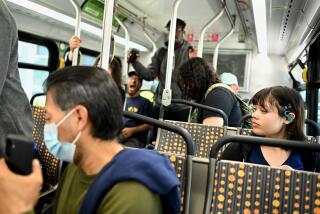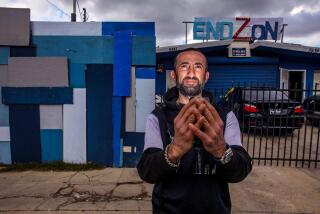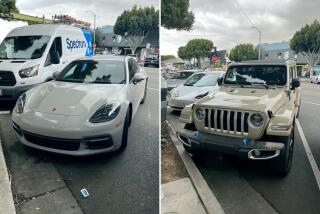THE SHINING : A paint job no longer costs $29.95 but the Southland is still the largest U.S. market for the colorization of cars.
- Share via
The owners of Collide-O-Scope Auto Paint & Body shop in El Monte have seen and nearly painted it all.
There was the young man who wanted his 1964 Impala painted Day-Glo Green. The middle-aged woman who wanted the color of her aging Thunderbird to match her favorite lavender belt. Then, there was the young woman who wanted her Volkswagen painted pink--not any pink, bubble-gum pink--and she brought in a piece of gum to show the painter.
In car crazy Southern California, such requests no longer faze many of the more than 4,000 auto paint shops owners. The region embraced the idea of giving a paint jobs to old cars long ago, giving rise to the nation’s first auto painting chains. Now, the rest of the nation is rapidly following suit.
“The Los Angeles and Orange County market is far stronger than any other market in the country,” said Mark A. Martino, national director of operations for the 425-shop Maaco auto paint and body chain--the nation’s largest.
“In many parts of the country there is a stigma to getting a car repainted,” Martino said. “However, in California, there’s no stigma--it’s a positive thing to do.”
If an auto painter wants to establish a lucrative business, it seems Southern California is the place to be. More cars are concentrated in Southern California than in any other part of the country. More households have second and third cars--the cars most likely to be repainted. Californians paint their cars more often than car owners nationwide, some industry experts say.
A Diverse Industry
Los Angeles is home to the most recognized name in bargain basement-priced auto painting: Earl Scheib, who began painting cars in 1937. Not too many Southern California residents in the 1960s and 1970s went without viewing a Scheib television commercial or hearing the slogan: “Hi, my name is Earl Scheib and I will paint any car for $29.95.” (It’s $99.95 now.)
The large number of autos on the road has led to a diverse industry. Along the automobile repair rows that line many Southern California streets, car owners can find “pound-and-paint” outfits that will mend and paint a fender for less than $100 in a few hours or custom shops that will take six weeks and charge $4,500 and up to paint a European sedan.
The Torrance-based 1 Day Paint & Body Centers chain and Gordon’s Body Shop in Redondo Beach represent extremes in auto painting techniques and philosophy.
On a recent rainy weekday, 19 cars, pick-up trucks and vans sat inside 1 Day’s flagship shop on Western Avenue in Torrance. Workers shouted over the din of sanding machines, the pounding of mallets, and the constant rat-tat-tat-tat of the air compressor motor, which paint shops depend on to run nearly everything from spray paint guns to jitterbugs--a popular hand-held sander.
Here, autos follow a procedure mimicked at the 32 other 1 Day shops from Los Angeles to Albuquerque. First any dents are fixed, the car’s surface is sanded, primer is applied and windows and moldings masked with tape and paper. (Like most paint shops, most of the cars that come into 1 Day need body work as well.)
The painting itself--completed in an enclosed booth under lights designed to simulate sunlight--takes only half an hour. The painted car is driven into a gas-heated oven and then sits overnight before being returned to the customer. The average bill for paint and body work is $300.
All told, 1,750 cars a week--90,000 a year--pass through the 1 Day chain. “It’s an assembly line type of thing,” said J. R. (Rick) Uribe II, marketing director for 1 Day, which will post nearly $35 million in sales this year.
“This is kind of middle of the road auto painting,” said Uribe, whose father founded the chain in 1967. “This isn’t the place for a new Rolls-Royce.”
Gordon’s Body Shop, however, is the place to get a new paint job for your Rolls-Royce. While Buicks and inexpensive Toyotas are common at 1 Day, Mercedes-Benzes, Jaguars and Acura Legends fill the parking lot and garages at Gordon’s.
At Gordon’s, the staff strips off the car’s original paint and the doors and moldings are removed before painting. After painting, a car will sit one week to allow the paint to cure, said owner George Squyres, who bought the shop from the founder in 1984. The car is then lightly sanded and buffed.
The owner of a four-door sedan can expect to wait up to six weeks and pay $4,500 or more for a new coat of paint at Gordon’s, which paints only two whole cars a month. “There are people around who will pay $5,000 for a paint job,” said Squyres, who has been working on cars since age 14. “That’s why shops like mine survive.”
Squyres, like other paint shop owners, says a new coat of paint improves not only a car’s value, but also changes its personality. A conservative looking, ivory-colored Jaguar XJS that has been repainted black “looks aggressive,” he said. “It looks sinister, almost.”
For an auto painter, matching a new color to an existing coat of paint can sometimes be a major challenge. The popular new metallic paints and layers of protective gloss have complicated the job over the years, painters say.
Easy to Find Job
“Matching colors is quite frankly a gift,” said Kenneth R. Zion, professor of auto repair at El Camino Community College. “You’re either a born color matcher or you’re not.”
“It’s a dirty job,” said Juan Gudino, a 37-year-old auto painter spotted with fire engine red paint. But with 15 years of experience, Gudino says he has no trouble finding a job. “Anytime I look for a job,” he said, “I can find it on the same day, maybe within one week.”
Experienced workers such as Gudino are getting harder to find. “Who would like to go into an industry where you start out at $5 an hour, breathe materials that are toxic and have very little room for advancement?” Squyres asked.
Compounding the problem is the new immigration law. Many Southern California paint shops, which rely heavily on Mexican immigrants for labor, say they have found it harder to find workers since the law went into effect about a year ago.
Besides the labor shortage, auto shops are bracing themselves for tougher anti-pollution regulations that could require the purchase of costly new equipment, shop owners say.
Cities have also restricted the building of auto paint and body shops, considered by many to be eyesores. Recently, the city of Los Angeles began cracking down on shops that have continued to work on cars outdoors in violation of city regulations.
With intense competition and increasing government regulation, an auto painter needs more than a steady hand, an eye for color and a love for cars to stay afloat.
“You could be the best paint man in the world, but if you don’t know business, you’ll go bankrupt,” said Ron Baker, a former art major who, along with his brother, operates Baker Paint & Body Shop in Pasadena.






